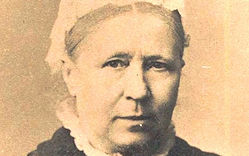Mary Taylor (1817–1893), an early advocate for women’s rights, was born in Gomersal in the West Riding of Yorkshire, England.
In 1845 Mary followed her youngest brother to New Zealand, and was joined by her cousin Ellen four years later. The women opened a drapery and clothing shop, which provided them with a good living. Mary had returned to Yorkshire by 1860, by then financially secure.
Mary contributed articles to Emily Faithfull’s Victoria Magazine championing feminist issues, women’s suffrage and property rights. In her only novel, Miss Miles, or, A Tale of Yorkshire Life Sixty Years Ago, she advocated a working life for women.
Early life
Mary Taylor’s father Joshua, a cloth manufacturer, and his wife Anne had six children of which she was the fourth. Her father was a Radical and member of the Methodist New Connexion. He was bankrupted in 1826, but true to his religious principles, determined to repay his creditors.
Mary was an impulsive, clever child who shared her father’s independent traits. She met Ellen Nussey[1] and Charlotte Brontë in 1831 at Roe Head School in Mirfield, where they became firm lifelong friends despite their differing views. At school Mary, although quiet, was defiant, standing by her opinions and practising what she preached. Charlotte was a visitor to Mary’s home, Red HouseHouse built in 1660 by William Taylor, whose descendants owned it until 1920. The Taylor family were farmers and clothiers, who developed their business into cloth finishing and became merchants. in Gomersal, and described the family’s company as “one of the most rousing pleasures I have ever known”.[2] In her novel Shirley, Mary’s family corresponds to the Yorke family, and the twelve-year-old Mary was the inspiration for the “sharp, precocious, and outspoken” Rose.[3]
Overseas
After Joshua Taylor’s death in December 1840, Mary embarked on a European tour before joining her sister at the Château de Koekelberg, a finishing school in Brussels. She corresponded with Charlotte Brontë describing what she had seen on her travels and inspiring her to go to Brussels in 1842. After her sister’s death in October 1842, Mary went to Germany where, challenging established convention, she found employment teaching young men.[2]
In March 1845 Mary followed her youngest brother, Waring, to Wellington, New Zealand where he had arrived in 1842. Her cousin Ellen joined them in 1849 and the women built a house and opened a drapery and clothing shop. When her cousin died in 1851, Mary bought her share and the shop continued successfully selling goods sent from England. She never intended to remain in New Zealand, and sold the shop that had provided her with a good income in a way a middle-class woman would have found impossible in England. Mary returned to Yorkshire before 1860.[4]
Yorkshire
Now financially secure, Mary returned to Gomersal where High Royd, the house built for her, became her home for the rest of her life. She made annual visits to Switzerland where, aged almost 60 in 1875, she led a party of five women on an expedition to climb Mont Blanc; they published Swiss Notes by Five Ladies, an account of their ten-week adventure.[2]
Mary contributed articles to Emily Faithfull’s Victoria Magazine championing feminist issues, women’s suffrage and property rights. She worked on her only novel, Miss Miles, or, A Tale of Yorkshire Life Sixty Years Ago, for forty years before it was published in 1890. It strongly advocates a working life for women.[2]


